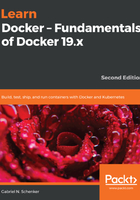
Using Dockerfiles
Manually creating custom images, as shown in the previous section of this chapter, is very helpful when doing exploration, creating prototypes, or authoring feasibility studies. But it has a serious drawback: it is a manual process and thus is not repeatable or scalable. It is also as error-prone as any other task executed manually by humans. There must be a better way.
This is where the so-called Dockerfile comes into play. A Dockerfile is a text file that is usually literally called Dockerfile. It contains instructions on how to build a custom container image. It is a declarative way of building images.
In computer science, in general, and with Docker specifically, one often uses a declarative way of defining a task. One describes the expected outcome and lets the system figure out how to achieve this goal, rather than giving step-by-step instructions to the system on how to achieve this desired outcome. The latter is an imperative approach.
Let's look at a sample Dockerfile, as follows:
FROM python:2.7
RUN mkdir -p /app
WORKDIR /app
COPY ./requirements.txt /app/
RUN pip install -r requirements.txt
CMD ["python", "main.py"]
This is a Dockerfile as it is used to containerize a Python 2.7 application. As we can see, the file has six lines, each starting with a keyword such as FROM, RUN, or COPY. It is a convention to write the keywords in all caps, but that is not a must.
Each line of the Dockerfile results in a layer in the resulting image. In the following screenshot, the image is drawn upside down compared to the previous illustrations in this chapter, showing an image as a stack of layers. Here, the Base Layer is shown on top. Don't let yourself be confused by this. In reality, the base layer is always the lowest layer in the stack:

Now, let's look at the individual keywords in more detail.